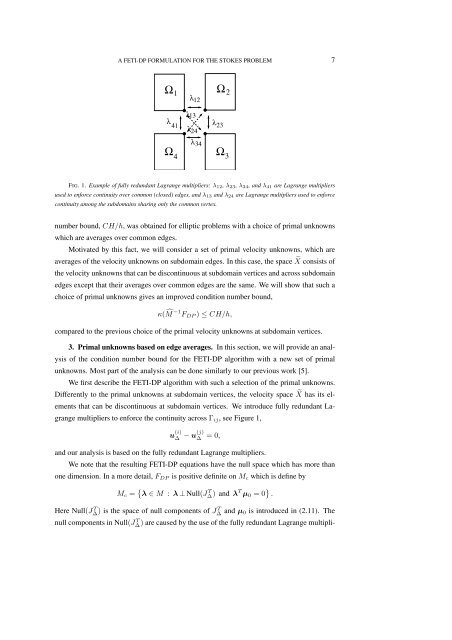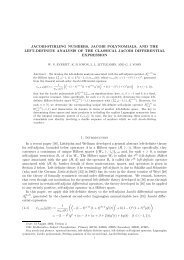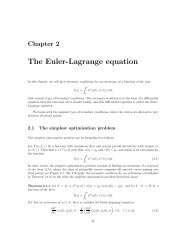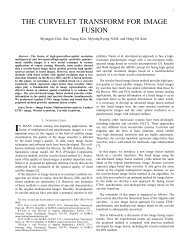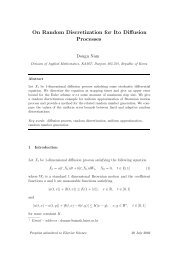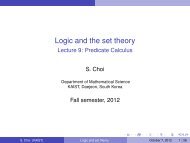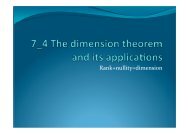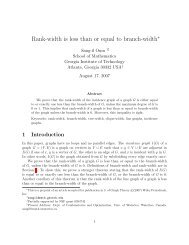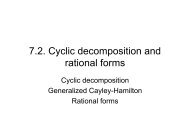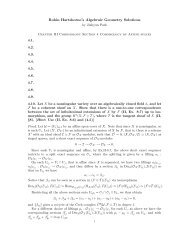On the selection of primal unknowns for a FETI-DP formulation of the ...
On the selection of primal unknowns for a FETI-DP formulation of the ...
On the selection of primal unknowns for a FETI-DP formulation of the ...
- No tags were found...
Create successful ePaper yourself
Turn your PDF publications into a flip-book with our unique Google optimized e-Paper software.
A <strong>FETI</strong>-<strong>DP</strong> FORMULATION FOR THE STOKES PROBLEM 7ΩΩ1 2λ 12λ 23λ 41Ω4λ13λ 24λ 34Ω3FIG. 1. Example <strong>of</strong> fully redundant Lagrange multipliers: λ 12 , λ 23 , λ 34 , and λ 41 are Lagrange multipliersused to en<strong>for</strong>ce continuity over common (closed) edges, and λ 13 and λ 24 are Lagrange multipliers used to en<strong>for</strong>cecontinuity among <strong>the</strong> subdomains sharing only <strong>the</strong> common vertex.number bound, CH/h, was obtained <strong>for</strong> elliptic problems with a choice <strong>of</strong> <strong>primal</strong> <strong>unknowns</strong>which are averages over common edges.Motivated by this fact, we will consider a set <strong>of</strong> <strong>primal</strong> velocity <strong>unknowns</strong>, which areaverages <strong>of</strong> <strong>the</strong> velocity <strong>unknowns</strong> on subdomain edges. In this case, <strong>the</strong> space ˜X consists <strong>of</strong><strong>the</strong> velocity <strong>unknowns</strong> that can be discontinuous at subdomain vertices and across subdomainedges except that <strong>the</strong>ir averages over common edges are <strong>the</strong> same. We will show that such achoice <strong>of</strong> <strong>primal</strong> <strong>unknowns</strong> gives an improved condition number bound,κ(̂M −1 F <strong>DP</strong> ) ≤ CH/h,compared to <strong>the</strong> previous choice <strong>of</strong> <strong>the</strong> <strong>primal</strong> velocity <strong>unknowns</strong> at subdomain vertices.3. Primal <strong>unknowns</strong> based on edge averages. In this section, we will provide an analysis<strong>of</strong> <strong>the</strong> condition number bound <strong>for</strong> <strong>the</strong> <strong>FETI</strong>-<strong>DP</strong> algorithm with a new set <strong>of</strong> <strong>primal</strong><strong>unknowns</strong>. Most part <strong>of</strong> <strong>the</strong> analysis can be done similarly to our previous work [5].We first describe <strong>the</strong> <strong>FETI</strong>-<strong>DP</strong> algorithm with such a <strong>selection</strong> <strong>of</strong> <strong>the</strong> <strong>primal</strong> <strong>unknowns</strong>.Differently to <strong>the</strong> <strong>primal</strong> <strong>unknowns</strong> at subdomain vertices, <strong>the</strong> velocity space ˜X has its elementsthat can be discontinuous at subdomain vertices. We introduce fully redundant Lagrangemultipliers to en<strong>for</strong>ce <strong>the</strong> continuity across Γ ij , see Figure 1,u (i)∆ − u(j) ∆ = 0,and our analysis is based on <strong>the</strong> fully redundant Lagrange multipliers.We note that <strong>the</strong> resulting <strong>FETI</strong>-<strong>DP</strong> equations have <strong>the</strong> null space which has more thanone dimension. In a more detail, F <strong>DP</strong> is positive definite on M c which is define byM c = { λ ∈ M : λ ⊥ Null(J T ∆) and λ T µ 0 = 0 } .Here Null(J T ∆ ) is <strong>the</strong> space <strong>of</strong> null components <strong>of</strong> J T ∆ and µ 0 is introduced in (2.11). Thenull components in Null(J∆ T ) are caused by <strong>the</strong> use <strong>of</strong> <strong>the</strong> fully redundant Lagrange multipli-


